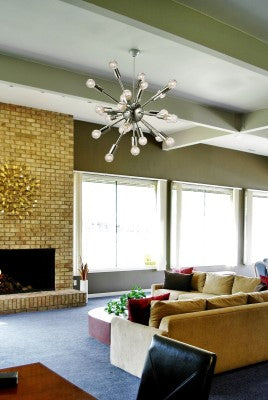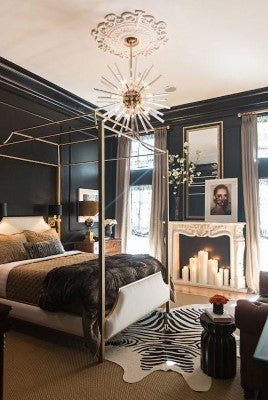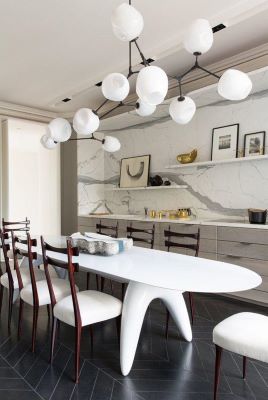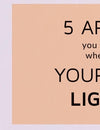-
Collections
Quirky contemporaryFull collectionMajestically ModernFull collectionArtisanal OriginalFull collection
- Categories
- Room
- Inspiration
There is a new star in the lighting world; L.E.D. ! Well, 'new' isn't exactly the right word as the first LED was invented over 50 years ago but it must been said that today the light source is hotter than ever. But exactly what are LED lights and why are they so beneficial versus incandescent or fluorescent lighting? Read on and you shall find out!
What are LEDs?
LED is the acronym that stands for light-emitting diode and illuminates by the movement of electrons through a semiconductor material. Too technical? Let me bring it down a little while comparing it to incandescent and fluorescent lighting.
Incandescent lighting (the good old peer or the halogen bulb) is like burning a campfire. You just take a metal instead of wood, ignite it with current and it lights up. Great and very easy but as you might have noticed they become very hot (it a fire after all) and will burn out rather fast as you cannot put any new metal in the bulb like you do with wood during a campfire.
A fluorescent light source, whether it is a long tube or a spiral (Compact Fluorescent Lighting or CFL) is a little more complicated where instead of igniting a solid material like metal or wood, you ignite gas in a tube. Sounds very spectacular but as you know from Hollywood movies; spectacular things usually blow up in the end. I simplify it a lot but you get the picture.
Now, then there is LED and let's compare that with the top and bottom of a popular waterslide in any public outdoor pool on a hot summer day. (Picturing it?) Ok, on top of the slide there are lot a of people waiting to go down, whereas down below there are just some trying to get out of the way of the next one coming. People will just slide down without any effort and scream their lungs out while doing it. Not sure if this leads to something useful? Well now, replace the waterslide with two different materials next to each other, the people with electrons and the screams with light flashes. You see, one material will be full of electrons (the top of the slide). the other will be almost empty (the bottom). Electrons will flow from the crowded place to the empty one (sliding down) and emit light (screaming 'wheeeeeee') while doing it. There we go, easy isn't it? Now as you know screams of joy around a waterslide almost never gets exhausted, you just need to have people going round and round (current) and it will be good for 20 years unlike our fire pit where you constantly need to keep adding wood to keep it burning. The comparisons might seem far apart but that is in fact how different these two technologies are.
source: Wikipedia 2013
What is so great about LED?
Immediately you can see from the above the first benefit of LEDs; lifetime. Where a typical conventional incandescent bulb lasts around 1,000-2,000 hours, a halogen maybe 3,500 and a fluorescent 8,000 hours, a LED can last 25,000 hours or more. (it takes a whole lot of sliding before it breaks down). It is also not that sensitive for a lot of on-and-off switching and does not need to warm up like CFL's. Choose LED lighting and probably never buy a bulb again!
Also it takes much less effort to create light (just slide down) so the energy consumption goes down which helps saving the planet and, especially, dollars on your energy bills. Two times hurray! On estimate you will save $15 per year per LED bulb. Now start counting the number of bulbs in your home, you will be surprised how fast it adds up!
Many people like you and me however are hesitant to buy one of these bulbs because of the 'high' initial cost price. Even though the price today is approaching $10 for a high quality bulb from Philips or Cree, it is still 20x more than that good old (but hot and inefficient) conventional one. Savy shoppers however know that the 'investment' easily returns itself. So be smart and go for LED! Lumigado.com makes it even easier for you and simply includes a high quality LED bulb with a selection of its lamps and fixtures. Check it out here!
|
Cost Comparison | ||||||
|---|---|---|---|---|---|---|
|
|
Incandescent |
Halogen |
CFL |
LED (Generic) |
|
|
|
Purchase price |
$0.41 |
$4 |
$4 |
$10 |
|
|
|
Electricity usage |
60 W |
42 W |
13 W |
13.5 W |
|
|
|
Lumens |
860 |
570 |
825 |
850 |
|
|
|
Lumens/Watt |
14.3 |
13.6 |
63.5 |
63 |
|
|
|
Color Temperature Kelvin |
2700 |
3000 |
2700 |
3000 |
|
|
|
Lifespan (hours) |
2,000 |
3,500 |
8,000 |
25,000 |
|
|
|
Bulb lifetime in years @ 6 hours/day |
1 |
1.6 |
3.7 |
>11.4 |
|
|
|
Energy cost over 10 years @ 15 cents/kWh |
$197 |
$138 |
$43 |
$44 |
|
|
|
Total |
$201 |
$166 |
$55 |
$54 |
|
|
|
Comparison based on 6 hours use per day (21,900 hours over 10 yrs) | ||||||
source: Wikipedia.com, 2013 (link)
Beside lifetime and costs, there is another great advantage of LED; size. Often a LED is only about two stacked dimes in size which is much less compared to bulky light bulbs and tubes. Manufacturers today make LED bulbs resembling the shape of bulbs to make it retro fit (the first cars also looked like carriages) but they actually do not have to. This allows lighting designers to experiment with new forms and designs often with stunning results. For example take a look at the Yumi, Lepora and the Tight.
Yumi Floor lamp 'Tight' pendant
Furthermore by combining them in different color sets, LEDs have the added capability to emit virtually every shade of light there is. (Except brown I noticed... but who wants that one anyhow).
How do I choose the right LED?
Hopefully by now, you are fully convinced that LEDs are the lighting solution for your house in the future. If you would have gone to the marketplace for some you most likely would have seen that there are many different ones out there today. So in order to choose the right on, simply follow the next points of advise.
1. Quality - When it comes to LED bulbs. Do not go for the cheapest solution if it has a brand you have never seen before or, even worse, if you cannot even pronounce it! There is a lot of junk out there today that will decrease you experience; the light will be too white or even blue, there will be not enough light or the LED will simply not work. No, stay with the brands you thrust; Philips, GE, Sylvania, Cree, Samsung and Toshiba to name a few. The price difference you pay at the start will be pennies over the lifetime of the LED. So buy quality!
2. Bulb sizes and fitting - LEDs are available in almost every size and shape, simple buy the fitting you have available or buy the same or smaller size. It is not complicated.
3. Color temperature - Uhm, what? Yes, this reflects the 'yellowness' of the light emitted. Think about it for a second. In your office it might be pretty clear white whereas you living room is probably more cozy yellowish. Exactly! LEDs can do both so on one hand watch out for this and on the other hand use it! Place whiter lights on places where you need to get tasks done (office, kitchen, bathroom) and more yellow lights on places you want to relax (living room, bedrooms). The color temperatures are expressed in degrees Kelvin (K) (no, not degrees Kevin) and the higher, the whiter. In general 2,700K (it will be on the packaging) resembles the more yellow conventional incandescent whereas 3,000K the white halogen or fluorescent.
4. Lumen & Watt - Where are the days when were looking for 40W or 60W bulbs... well, they will be soon gone! Lumen (lm) is the new watt (W) and reflects how much light is emitted instead of how much energy is used! Since LEDs are so much more efficient, they use less energy for the same amount of light. So a 60W conventional bulb will be the same as a 13.5W LED which would make it very very confusing for people like you and I (especially me). In a different learning post we go in depth on how much lumen you need in a room (find it here!) but for the sake of this one simply remember that;
- 40-watt incandescent = 450 lumens
- 60-watt incandescent = 800 lumens
- 100-watt incandescent = 1600 lumens
Often the manufacturers have already made the translation for you on the packaging. By the way, a lot of the information above you find on the label on the box. See under how it often looks like.

Source: Lumennow.org, 2013 (link)
This is the end, my friend. We hope you feel now a little bit wiser about LEDs and hope you join us in putting out some 'campfires' and go a little bit more often to the 'waterslides'. If you have any feedback, remarks or want to share your experiences. Feel free to comment under or go to our Facebook, Google+ or Twitter page. Or show us how great you home or office looks with LEDs; take a picture, load it to Houzz or Pinetrest and share with us!
Leave a comment









